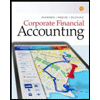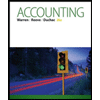
Concept explainers
(a)
Common stock: These are the ordinary shares that a corporation issues to the investors in order to raise funds. In return, the investor receives a share of profit from the profits earned by the corporation.
Par value: It refers to the value of a stock that is stated by the corporation’s charter. It is also known as face value of a stock.
No-par common stock: The common stock that is issued at its fair market value is known as no-par common stock. Common stocks are the ordinary shares that a corporation issues to the investors in order to raise funds. In return, the investor receives a share of profit from the profits earned by the corporation.
To Journalize: the issuance of common stock transaction at a par value of $5 per share for Corporation M on January 10.
To Journalize: the issuance of common stock transaction at $7 per share for Corporation M on July 1.
(b)
To Journalize: the issuance of common stock transaction at no-par value with a stated value of $1 for Corporation M on January 10.
To Journalize: the issuance of common stock transaction at no-par value with a stated value of $1 for Corporation M on July 1.
Trending nowThis is a popular solution!

Chapter 11 Solutions
Financial Accounting: Tools for Business Decision Making, 8th Edition
- Not chatgpt solutionarrow_forwardGeneral accounting questionsarrow_forwardin the first day of a company’s fiscal year, it has paid for and installed a machine for servicing vehicle engines at one of its outlets. The machine costs $40,000. Its annual cash operating costs total $30,000. The machine will have a four-year useful life and a zero terminal disposal value. After the machine has been used for only one day, a consultant offers a different machine that promises to do the same job at annual cash operating costs of $18,000. The new machine will cost $48,000 cash, installed. The original machine is unique and can be sold outright for $20,000, minus $4,000 removal cost. The new machine, like the old one, will have a four-year useful life and zero terminal disposal value. Revenues, all in cash, will be $300,000 annually, and other cash costs will be $220,000 annually, regardless of this decision. Ignore income taxes and the time value of money Suppose the cost of the original (old) machine was $2 million rather than $40,000.Nevertheless, the old machine…arrow_forward
- Lao Enterprises is preparing its direct labor budget for June. Projections for the month are that 18,200 units are to be produced and that direct labor time is 2.5 hours per unit. If the labor cost per hour is $14, what is the total budgeted direct labor cost for June?arrow_forwardABC Company produced 15,000 units and sold 12,000 units during its first year. The company provided the following information: Particulars Per unit Per year Selling price $180 Direct materials $45 Direct labor $30 Variable manufacturing overhead $15 Sales commission $9 Fixed manufacturing overhead ? Fixed selling and administrative expense $315,000 If the company's unit product cost under absorption costing is $120, what is the amount of fixed manufacturing overhead per year? a. $450,000 b. $360,000 c. $375,000 d. $480,000arrow_forwardAccounting question ?arrow_forward
- Answer me pleasearrow_forwardSunset Company reported net income of $120,000 using absorption costing. The company produced 30,000 units and sold 25,000 units during the year. Beginning inventory was zero. Fixed manufacturing overhead was $150,000, and the variable manufacturing cost was $15 per unit. There was no underapplied or overapplied overhead. Calculate Sunset Company's net income under variable costing. A. $95,000 B. $120,000 C. $145,000 D. $170,000arrow_forwardHello tutor please help me this question solutionarrow_forward
 Cornerstones of Financial AccountingAccountingISBN:9781337690881Author:Jay Rich, Jeff JonesPublisher:Cengage Learning
Cornerstones of Financial AccountingAccountingISBN:9781337690881Author:Jay Rich, Jeff JonesPublisher:Cengage Learning Corporate Financial AccountingAccountingISBN:9781305653535Author:Carl Warren, James M. Reeve, Jonathan DuchacPublisher:Cengage Learning
Corporate Financial AccountingAccountingISBN:9781305653535Author:Carl Warren, James M. Reeve, Jonathan DuchacPublisher:Cengage Learning Accounting (Text Only)AccountingISBN:9781285743615Author:Carl Warren, James M. Reeve, Jonathan DuchacPublisher:Cengage Learning
Accounting (Text Only)AccountingISBN:9781285743615Author:Carl Warren, James M. Reeve, Jonathan DuchacPublisher:Cengage Learning Financial AccountingAccountingISBN:9781305088436Author:Carl Warren, Jim Reeve, Jonathan DuchacPublisher:Cengage LearningPrinciples of Accounting Volume 1AccountingISBN:9781947172685Author:OpenStaxPublisher:OpenStax College
Financial AccountingAccountingISBN:9781305088436Author:Carl Warren, Jim Reeve, Jonathan DuchacPublisher:Cengage LearningPrinciples of Accounting Volume 1AccountingISBN:9781947172685Author:OpenStaxPublisher:OpenStax College




